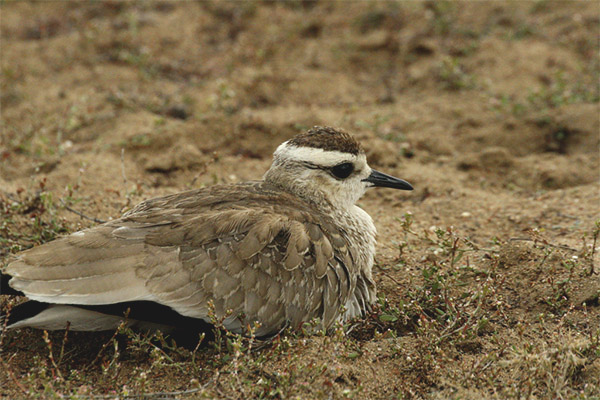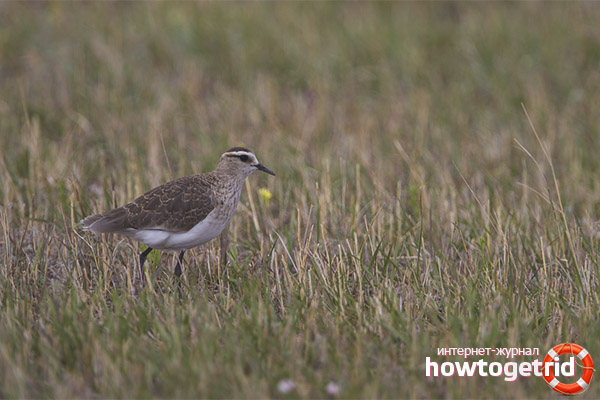The content of the article
The Krechetka is a small bird of the plover family. This species includes short-legged birds of medium and small size, which prefer to settle in shallow water. For the whole family is characterized by a small, thickened at the end of the beak, which the bird collects food from the ground. The bird got the name "Krechetka" due to its characteristic sound "Kresch-Krech-Krech". Krechetku is often confused with lapwing, but it is slightly smaller than the latter. Today, this steppe pigtail is at the stage of extinction and is listed in the Red Books of some regions of Russia. What is the Piglet, how it looks and where it lives, let's try to figure it out.
Appearance of the lapdog
Krechetka on the background of the whole family of plovers looks more than worthy - it has a dense build, the bird is quite graceful and elegant.The head of the lapdog is slightly larger than that of the ибibis, and the rest of the body, on the contrary, is slightly smaller. On the head there is no tuft characteristic of the lapwing. The beak of the lapdog is rather short, but the legs are unusually long. The size of the body of the lapdog is usually less than 30 cm, the wingspan is 70-80 cm, the average bird weight is 200 grams.
Krechetka has a color characteristic of the steppe landscape - its plumage is poured with brown, sand, gray, brown and earth shades. The back of the chest is black, the belly and chest are cast in a reddish tinge, and the area under the tail has a white color. The head and back of the head are also painted black. The female from the male can be distinguished by the size and intensity of the coloring color. In the female, the color of the breast is not red, but chestnut, the black areas have a calm, smoky shade. The male is distinguished by contrast and bright colors, especially in the mating season. The legs of the lapdog are four-fingered, black as the beak. Depending on the time of the year and age, the lapdogs can change their outfits. The young bird can be recognized by the characteristic speckled specks that are spread throughout the plumage.
Habitat
As a place of residence, the lapwing chooses dry steppes, semi-deserts and mountainous areas. At the same time, there should be a small freshwater reservoir nearby. Often the lapdog can be found on the sowing fields after collecting the feed crop. Krechetka prefers to settle in sparse grassy areas with wormwood and different types of cereals. The bird chooses small bald spots in dense vegetation or areas with gravelly soil. An ideal place for the lapwing is a dry piece of land with dense vegetation near a freshwater reservoir.
Features nesting prat
On average, birds live in their natural environment for about 3-4 years, the maximum lifespan was recorded in captivity - 12 years. Krechetka becomes sexually mature and is broken up into pairs by the second year of life. It is believed that the pairs are formed during the flight, the birds arrive at the nesting site already formed "families". No pronounced marriage games or "flirtations" of the male were recorded by scientists. Krechetka arrives at breeding sites in the first half of April, and in colder regions closer to the beginning of May. In Russian latitudes, a bird can be easily found in the steppe area, on last year's arable land, or just around villages and villages. The main condition is to have a pond nearby.
As a rule, the lapdog prefers to nest in small colonies, 3-5 pairs each. Between the nests remains at least 30 meters, this is the territory of each "family". Often the lapwing can nest in the neighborhood of lapwings and tirkushs. Building a nest is a quick and straightforward affair; birds choose a small indentation left by the hoof of cattle. Dry grass, cow and sheep dung, stalks and leaves of wormwood are lined in this depression.In one clutch there are about 3-4 eggs, which are similar to the offspring of a marigold. Eggs have a light green or pale brown shade with numerous specks and patches.
Care of the offspring, as a rule, falls on the female, the males in most cases leave the nesting sites immediately after laying. Sometimes the male can take care of the eggs in the early stages of incubation, replacing the female when she flies away to feed. However, these are isolated cases, mostly the female itself incubates chicks for three to four weeks. The female not only warms the eggs, but also carefully protects them from birds and amphibians of predators, even without fear attacking a person if it comes too close to the clutch. Eggs of the lapdog can be found in May and up to the middle of June. Later clutches are considered to be repeated, they are set aside if the nest with the first offspring was destroyed by predators.
After a specified time, the chicks hatch, which after a month and a half are able to stand on the wing. When the little ones get a little stronger and learn to fly well, the birds gather in flocks and wander along steppes, meadows and deserts in search of food.
Nutrition and numbers
Today, the number of the porpoise is catastrophically declining, tenfold. The number of individuals does not exceed 10 thousand pairs. The main enemy of the lapdogs are predators. Nests can be ruined by foxes, marsh moons, rooks, ravens. Often in the nesting areas are herds of cows and sheep, which are completely trampling eggs. Even pets, such as dogs, are not averse to feast on a young brood.
Today, the sandwich in every way guarded, it is listed in the Red Book of Russia, Uzbekistan and Kazakhstan. In the Orenburg region, the coniferous cat lives in a special steppe reserve.Perhaps artificial breeding of new offspring in the territories of various nurseries. Scientists and ornithologists are doing everything possible to increase the population of these amazing steppe birds.
Video: lapdog (Vanellus gregarius)












To send